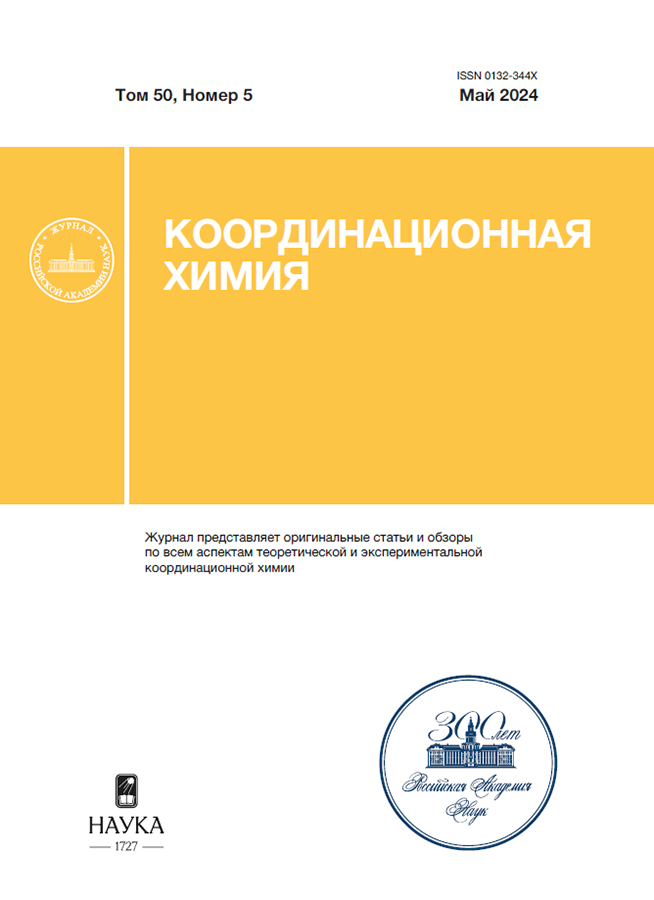Synthesis and Study of Mono(arylhydrazino)acenaphthenones and Nickel Complex based on Pyridine-substituted Derivative
- Authors: Bakaev I.V.1, Komlyagina V.I.1,2, Romashev N.F.1, Gushchin A.L.1
-
Affiliations:
- Nikolaev Institute of Inorganic Chemistry, Siberian Branch, Russian Academy of Sciences
- Novosibirsk State National Research University
- Issue: Vol 50, No 5 (2024)
- Pages: 287-295
- Section: Articles
- URL: https://cardiosomatics.ru/0132-344X/article/view/667596
- DOI: https://doi.org/10.31857/S0132344X24050012
- EDN: https://elibrary.ru/NKOJGP
- ID: 667596
Cite item
Abstract
Three mono(arylhydrazino)acenaphthenones, that is, mono(2-pyridylhydrazino)acenaphthenone (Py-mhan, L1), mono(4-cyanophenylhydrazino)acenaphthenone (4-CN-Ph-mhan, L2), and mono(3,4,6-trifluoro-2-pyridylhydrazino)acenaphthenone (FPy-mhan, L3), were synthesized by the reaction of acenaphthene quinone with the appropriate arylhydrazine salt; compounds L2 and L3 were obtained for the first time. The subsequent reaction of L1 with nickel chloride in 2 : 1 ratio led to the octahedral complex [Ni(Py-mhan)2] (I), in which Py-mhan acts as a tridentate ligand. All of the prepared compounds were characterized by elemental analysis, IR and 1H NMR spectroscopy, and cyclic voltammetry; the crystal structures of L3 and I were determined by X-ray diffraction.
Full Text
About the authors
I. V. Bakaev
Nikolaev Institute of Inorganic Chemistry, Siberian Branch, Russian Academy of Sciences
Email: nikolaj.romashev75@gmail.com
Russian Federation, Novosibirsk
V. I. Komlyagina
Nikolaev Institute of Inorganic Chemistry, Siberian Branch, Russian Academy of Sciences; Novosibirsk State National Research University
Email: nikolaj.romashev75@gmail.com
Russian Federation, Novosibirsk; Novosibirsk
N. F. Romashev
Nikolaev Institute of Inorganic Chemistry, Siberian Branch, Russian Academy of Sciences
Author for correspondence.
Email: nikolaj.romashev75@gmail.com
Russian Federation, Novosibirsk
A. L. Gushchin
Nikolaev Institute of Inorganic Chemistry, Siberian Branch, Russian Academy of Sciences
Email: nikolaj.romashev75@gmail.com
Russian Federation, Novosibirsk
References
- Wang, J., Soo, H.Sen., and Garcia, F., Commun. Chem., 2020, vol. 3, no. 1, p. 133.
- Fomenko, I.S. and Gushchin, A.L., Russ. Chem. Rev., 2020, vol. 89, no. 9, p. 966.
- Komlyagina, V.I., Romashev, N.F., Besprozvannykh, V.K., et al., Inorg. Chem., 2023, vol. 62, no. 29, p. 11541.
- Romashev, N.F., Mirzaeva, I.V., Bakaev, I.V., et al., J. Struct. Chem., 2022, vol. 63, no. 2, p. 242.
- Romashev, NF., Bakaev, I.V., Komlyagina, V.I., et al., J. Struct. Chem., 2022, vol. 63, no. 8, p. 1304.
- Fedushkin, I.L., Skatova, A.A., Chudakova, V.A., and Fukin, G.K., Angew. Chem., Int. Ed. Engl., 2003, vol. 42, no. 28, p. 3294.
- Fedushkin, I.L., Maslova, O.V., Baranov, E.V., and Shavyrin, A.S., Inorg. Chem., 2009, vol. 48, no. 6, p. 2355.
- Bendix, J. and Clark, K.M., Angew. Chem., Int. Ed. Engl., 2016, vol. 55, no. 8, p. 2748.
- Bernauer, J., Pölker, J., and Jacobi von Wangelin, A., ChemCatChem, 2022, vol. 14, no. 1, p. e202101182.
- Chacon-Teran, M.A. and Findlater, M., Eur. J. Inorg. Chem., 2022, vol. 2022, no. 30, p. e202200363.
- Johnson, L.K., Killian, C.M., and Brookhart, M., J. Am. Chem. Soc., 1995, vol. 117, no. 23, p. 641415.
- Leatherman, M.D., Svejda, S.A., Johnson, L.K., and Brookhart, M., J. Am. Chem. Soc., 2003, vol. 125, no. 10, p. 3068.
- Bridges, C.R., McCormick, T.M., Gibson, G.L., et al., J. Am. Chem. Soc., 2013, vol. 135, no. 35, p. 13212.
- Zhai, F. and Jordan, R.F., Organometallics, 2017, vol. 36, no. 15, p. 2784.
- Wu, R., Klingler, W., Stieglitz, L., et al., Coord. Chem. Rev., 2023, vol. 474, no. 1, p. 214844.
- Fedushkin, I.L., Nikipelov, A.S., Morozov, A.G., et al., Chem.-Eur. J., 2012, vol. 18, no. 1, p. 255.
- Yakub, A.M., Moskalev, M.V., Bazyakina, N.L., and Fedushkin, I.L., Russ. Chem. Bull., 2018, vol. 67, no. 3, p. 473.
- Arrowsmith, M., Hill, M.S., and Kociok-Kohn, G., Organometallics, 2011, vol. 30, no. 6, p. 1291.
- Saini, A., Smith, C.R., Wekesa, F.S., et al., Org. Biomol. Chem., 2018, vol. 16, no. 48, p. 9368.
- Tamang, S.R., Cozzolino, A.F., and Findlater, M., Org. Biomol. Chem., 2019, vol. 17, no. 7, p. 1834.
- Gushchi, A.L., Romashev, N.F., Shmakova, A.A., et al., Mendeleev Commun., 2020, vol. 30, no. 1, p. 81.
- Fomenko, I.S., Gongola, M.I., Shulʹpina, L.S., et al., Catalysts, 2022, vol. 12, no. 10, p. 1168.
- Romashev, N.F., Bakae, I.V., Komlyagina, V.I., et al., Int. J. Mol. Sci., 2023, vol. 24, no. 13, p. 10457.
- Bakaev, I.V., Romashev, N.F., Komlyagina, V.I., et al., New J. Chem., 2023, vol. 47, no. 40, p. 18825.
- Zhou, J.L., Xu, Y.H., Jin, X.X., et al., Inorg. Chem. Commun., 2016, vol. 64, p. 67.
- Zhou, J.L., Sun, H.W., Yin, D.H., et al., J. Mol. Struct., 2017, vol. 1134, p. 63.
- Gao, Q., Song, Y., Zheng, C., et al., J. Mol. Struct., 2020, vol. 1214, p. 128228.
- Su, Y.X., Zhang, C.Z., and Song, M.X., Acta Crystallogr., Sect. C: Struct. Chem., 2017, vol. 73, no. 6, p. 458.
- Sheldrick, G.M., Acta Crystallogr., Sect. A: Cryst. Adv., 2015, vol. 71, no. 1, p. 3.
- Sheldrick, G.M., Acta Crystallogr., Sect. C: Struct. Chem., 2015, vol. 71, p. 3.
- Hubschle, C.B., Sheldrick, G.M., and Dittrich, B., J. Appl. Crystallogr., 2011, vol. 44, no. 6, p. 1281.
- Soldatov, D.V., Mendeleev Commun., 1997, vol. 7, no. 3, p. 100.
- Bose, N. and Lynton, H., Can. J. Chem., 1973, vol. 51, no. 12, p. 1952.
- Zhang, H. and Fang, L., Acta Crystallogr., Sect. E: Struct. Rep. Online, 2005, vol. 61, no. 1, p. m1.
- Wriedt, M., Jess, I., and Nather, C., Acta Crystallogr., Sect. E: Struct. Rep. Online, 2010, vol. 66, no. 7, p. m780.
- Van Damme, N., Lough, A.J., Gorelsky, S.I., and Lemaire, M.T., Inorg. Chem., 2013, vol. 52, no. 22, p. 13021.
- Niklas, J.E., Farnum, B.H., Gorden, J.D., and Gorden, A.E.V., Organometallics, 2017, vol. 36, no. 23, p. 4626.
Supplementary files
















